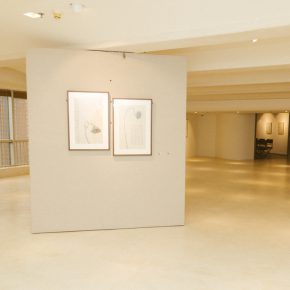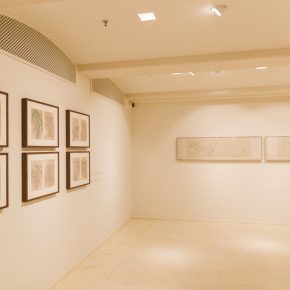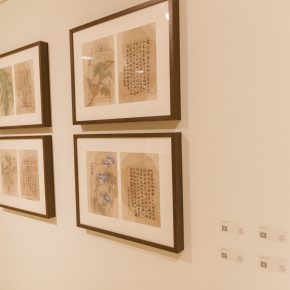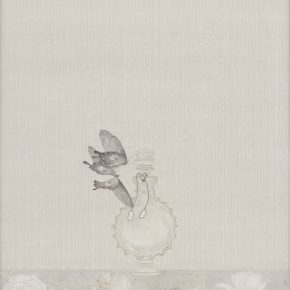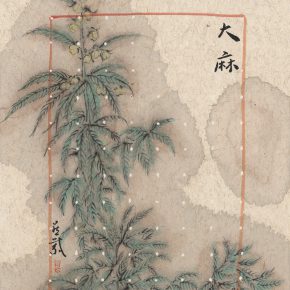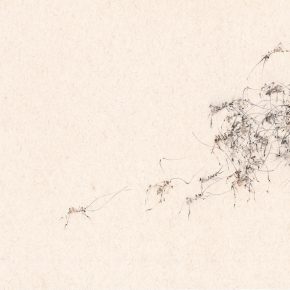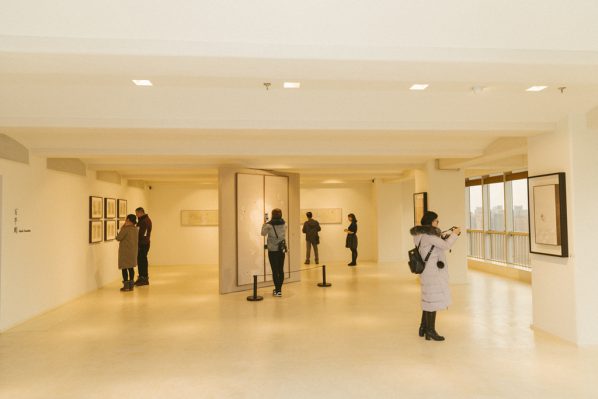
By Min Lijun
Here in “Herb Garden”, there are no small sections of vegetable plots or mulberry, acacia trees or stone well curbs as portrayed by Lu Xun, but we still build a paradise full of vegetation, with
the singing of birds and insects which are full of humor and fun. In recent years, the works by Gao Qian and Zhang Yanzi, two representative artists in the field of contemporary ink and wash,
are related to flowers, herbs, insects and ants as well as birds. They use their unique ink and wash narrative to depict their own comprehension of the world, life and emotions. The exhibition
entitled “Herb Garden”, presents the recent works by these two artists, let us walk in their herb garden, read and think about the relationship between the unique female perspective and artistic
expression, as well as the possibility of contemporary inheritance and conversion from traditional Chinese art expressions.
Gao Qian, a representative of the contemporary new Gongbi artists, the unique atmosphere of the South of the Yangtze River and elegant temperament have become her labels. In recent
years, she was particularly fascinated by the study of “scent filled images,” she studied plant components with fragrant smells and conveyed the fragrance to viewers through her images. Among
the dense aroma, the mating scenes of insects are portrayed, their happy union reminds us of the exquisite feelings in boudoirs. However, Gao Qian is not satisfied with the simple pattern from
the boudoir charm, beyond the women’s atmosphere her work is full of more inner emotions and a reorganization of fragments of the memory. These seemingly dreamy moments of emotions
are instantly frozen in her work, this has always been something Gao Qian wants to present. She admits that they are like human dreams, deja vu, fleeting and transitory, which leave infinite rêverie. Nietzsche describes the dream and drunkenness as two basic states of art, we could see the murmuring whispers behind her work.
This time she brings “Visiting the Immortals Cave” , “Jade Crossing Branch”, “Intercourse” series of works to this exhibition. In an elegant light color, insects or birds are gracefully moving
among flowers and plants, the revelation of images is obvious, leaving the viewer to comprehensively read and think. “Visiting the Immortals Cave” is a new work she created in 2016, six
works are divided into three groups, they respectively describe the flourishing and withering states of three different plants. Although the title from the legendary novel in the Tang Dynasty is
not directly related to the painter herself, which hides the slight mystery that corresponds to “Intercourse”.
Zhang Yanzi’s herbal theme started from her studies in Chinese herbs after the “Ancient Prescription” series of 2015. The expressions of Chinese and Western medicine and cures have
remained the motif of her work in recent years. Along with aging, she began to slowly understand the mystery and charming wonder of Chinese medicine and she has become interested
in the various forms of herbs. Zhang Yanzi, who is well versed in traditional culture and western contemporary art, has always been able to explore the multiple metaphors of ideas, language
and materials. Based on the study of the famous Chinese medicine “Compendium of Materia Medica”, she has conducted a re-interpretation of ancient prescriptions, she found that “everything is medicine, while everything is not medicine” and the secret lies in the “occasion” and “standard”.
This time Zhang Yanzi brings “Ecstasy”, “Ksana”, “Itches” and “Loving Lotus” series to this exhibition, among which “Ecstasy” which was specially commissioned for this exhibition, it portrays
six herbs that could bring about ecstasy including heaven blue, poppy, dead rattan, mandala, marijuana and absinthe. She continues the creative method she used in the “Ancient Prescription”, a painting of herbal medicine with a calligraphy interpretation, six groups of twelve pieces constitute the complete illustrative plates of “Ecstasy”. These psychedelic herbs come from all over the world, South America, India, or West Asia, under the beautiful appearance, they imply the seeds of danger, they are drugs and medicines, they bring happiness as well as comfort to people and they also bring dependence and addiction. Here, good and bad are not absolute, but they can be converted. This antagonistic and contradictory relationship attracts us and everyone can provide a different interpretation according to their individual experience.
Observing the paintings by Gao Qian and Zhang Yanzi, we will find an interesting contrast between them. Although their works are endowed with the atmosphere of the South of the Yangtze River, female sensitivity and elegant style. But the deep bitterness in Yanzi’s work and the elegant rhythm in Gao Qian’s paintings, form a strong contrast. Yanzi’s acuteness and Gao Qian’s elegance, are both hard to forget. They depict Nature and they transcend Nature, with their natural born radar of female sensitivity, they have discovered other functional senses besides the visual, such as smell, taste, and touch, so as to achieve “synesthesia” and “correspondence”. In form and content, between ancient and contemporary they have found a balance.
While the academic circle creates continuous discussions about the “contemporary nature of ink painting or Gongbi (meticulous painting) “, we might look at the practices of Gao Qian and
Yanzi, they have used their own cultivation, thinking and perception, to make breakthroughs in individual innovation and narrative. It is every artist’s unremitting effort that encourages new Chinese ink painting and new Gongbi so there is a more diversified development which also provides more possibilities.
The exhibition will remain on view at Mi You Space till January 25th, 2017.





